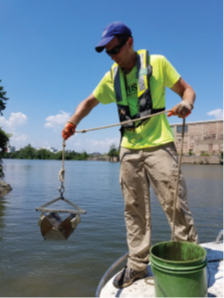Together with the New York State Department of Environmental Conservation (DEC), Erie County, Buffalo Niagara Waterkeeper, and the Buffalo River Remedial Advisory Committee, the US EPA has announced the removal of the Degradation of Benthos Beneficial Use Impairment (BUI) at the Buffalo River Area of Concern (AOC). This BUI was removed on September 5th, 2023. BUIs are designations listed in the 1987 amendment to the Great Lakes Water Quality Agreement that represent different types of significant environmental degradation (see Beneficial Use Impairments for the Great Lakes AOCs to learn more). The GLRI provided significant funding for the remediation work required to remove this BUI.
The Buffalo River AOC has been significantly altered from its natural state by industrial activity and suffered a number of ecological impairments as a result. From the late 1800s through 1980s, contaminants leaching and being discharged into the river from industrial facilities led to high sediment toxicity within the AOC. Navigational dredging also altered the structure of the Buffalo River from a shallow river to a deeper, lake-like habitat. The bottom-dwelling invertebrate community, or benthos, within the Buffalo River AOC was low in diversity and abundance, likely caused by exposure to toxic sediments and alterations to the benthic habitat.
In 2007, US EPA, DEC, Buffalo Niagara Waterkeeper, US Army Corps of Engineers (USACE), the City of Buffalo, and Honeywell, Inc. formed the Buffalo River Restoration Partnership Coordination Team. This team developed and implemented the remedial actions required to address the impaired benthos in the Buffalo River AOC. To resolve issues with sediment toxicity, the team first implemented practices to control sources of contamination at active industrial sites to prevent further contamination in the AOC. Additionally, the team dredged and removed more than a million cubic yards of contaminated sediment from the river and strategically placed a clean ‘cap’ on top of several areas within the AOC to prevent the potential residual contaminants from becoming re-suspended in the water.
After dredging and capping was completed, the US Geological Survey (USGS) and USACE conducted several assessments to measure the effects of exposure to sediment in the remediated areas on benthic invertebrates. Results of these assessments showed that the remedial action successfully reduced sediment toxicity so that it no longer significantly limits growth and survival of benthic invertebrates in the AOC. Additionally, when compared to long-term data, recent surveys of the resident benthos show that species diversity and abundance have improved since the benthos was first designated as impaired and are now similar to reference areas. Together, these data satisfy the criteria for removing this BUI. The Degradation of Benthos BUI is the fifth to be removed in the Buffalo River AOC, and only four BUIs remain.



